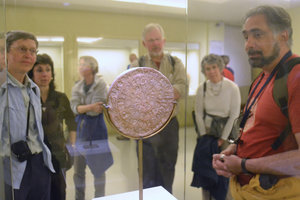Advertisement

 Phaistos Disk
Phaistos Disk
In the presence of a world treasure!We were only able to see the highlights of the
Archeological Museum because the main part is under (reportedly) interminable refurbishment. The most famous pieces are housed in a temporary area. The beauty of each piece made me want to linger. The most famous is the black Minoan bull head with gold horns and mother of pearl snout – for libations. Even more important is the
Phaistos Disk which is being used to decipher ancient
Minoanscript; Kriton explained that this is very difficult because most of the written texts are inventory lists dated to the massive fire caused by the explosion of Santorini.
Our bus took us to the suburbs of Heraklion, a city of 250,000 people. The buildings are mostly cement (for earthquake resistance) and block-ish in design (Typical Greek inheritance). The streets are unlovely – full of traffic, commercial signs and wires everywhere. In one of these unlovely buildings we met a most lovely artist,
Vassilis Politakis , a famous potter.
He gave us a lively presentation on pottery, and particularly Minoan pottery. He is well known and widely consulted for his success in recreating Minoan pottery using the ancient techniques, as researched by him.
For our demonstration he

 Scary traffic!
Scary traffic!
Highly emotive sculpture by students of Vassilis Politakistook us swiftly through the thought process of deriving what was possible from what was found in archeological sites. Using logic and simple elements he made a “slow” potter’s wheel (no kick action for spinning the wheel). He went on to demonstrate how to fire pottery, using a little, doll-sized kiln and twigs. He gave first the scientific explanation of how the black colouring on the pottery was achieved and then his charming explanation for children, for which he uses dolls. His whole delivery was comic and imaginative – a genius. He finished by making a rough, wet version of the Minoan bull, using the wheel for all parts. Even more magical was his story about the wildly comic figurines we could see all over the studio – he had taught some 13-year-olds pottery and they had made them all in a single three-hour class! The subjects were all the things that troubled them.
We drove out of town to Assites, a village with (to me) an extraordinary church. It was opened just for us. Quite small, it had twin naves – one for Christ and St John, and one for Mary. All over were special little details and

 Story Panels
Story Panels
Across the church painted panels depict the stories of the Bible for the illiterate. embellishments. Across the tops of the two altar enclosures were small rectangular paintings of the life of Christ. Quite soon we were ushered out, leaving a lasting but fragmented impression.
We walked further across the village, seemingly a collection of almost non-descript buildings. In one we had a low-key, minimalist presentation from one of the few Cretans who can still make brass sheep and cow bells. A short distance away, we entered one of the houses for lunch.
This was a 150-year-old building, a quite depressing place to live, in my eyes. It was a lean-to shape, with a presumably tiny bedroom on the second level. We ate in the long main room, while four women worked at one end behind a counter – the kitchen. There was almost nothing in the building besides the tables for the fourteen of us, although there were family pictures and a stereo to one side. However, the lunch was delicious and plentiful. We all had our fill of salad, meat balls in tomato sauce, bread, zucchini grilled with cheese and tzatziki, only to realize that the main course was coming – lamb thoroughly charred yet tender, with two potatoes in olive

 Lunch in Assites Village
Lunch in Assites Village
A rare moment to accept the hospitality of the village women.oil! This was accompanied by what I have previously read as “rough Cretan wine” – a raw wine with little to recommend it. We finished with a common dessert – peeled, sliced apple – very sweet and a bit crunchy.
Stuffed, we strolled back through the village to the bus. The return journey was on the same highway, along mountainous hills and valleys, all with olive and wine fields. Back in town, we visited the
St Minas Church – the eighteenth century one. Beside it is the thirteenth century building. The “new” one is unusual because the ceilings are painted with magnificent Byzantine-style depictions of the events in the life of Christ. Kriton explained that these scenes are prescribed in their content and style, knowledge that is taught in modern schools.
Byzantine paintings have virtually no background, because content beyond the story is unimportant. Even so, these later Byzantine-style depictions do have some stylized hills in them and even the faces and bodies are less two-dimensional and stiff.
We finished with a short stroll by the main square with the not-operating
fountain of St Mark , a Venetian structure. At the hotel just in time for our 5:00 – 8:00 lecture in Greek

 Cathedral of St Minas
Cathedral of St Minas
Huge Byzantine paintings - such a contrast to the church in Assites!history Part One! Wow! Long, but a passionate teacher. Buffet dinner at the hotel and to bed, with a look at the BBC highlights of the wedding of Prince William and Kate Middleton.
Advertisement
Tot: 0.13s; Tpl: 0.011s; cc: 11; qc: 30; dbt: 0.0863s; 1; m:domysql w:travelblog (10.17.0.13); sld: 1;
; mem: 1.1mb
















Jean C.
non-member comment
Hi Judith
I'm so appreciative of your doing this. I feel like sharing all this with all around me! Great pix. Be well, Jean C.